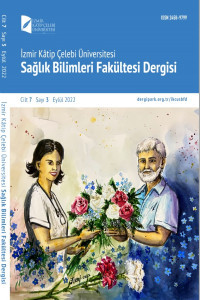Akıllı Telefon ve Tablet Kullanım Süresinin Kısa Süreli Hafıza Performansına Etkisi
Anahtar Kelimeler:
Kısa süreli hafıza, beyin, hipokampüs, tablet ve telefon kullanımı
___
- Alvarez, G.A., & Cavanagh, P. (2004). The capacity of visual short term memory is set both by visual İnformation load and by number of objects. Psychological Science, 15,106-111.
- Baddeley, A.D. (2000). The episodic buffer: a new component of working memory? Trends in Cognitive Science, 4,417-423.
- Brown, G.D.A., & Hulme, C. (1992). Cognitive processing and second language processing: The role of short term memory. In R. J. Harris (Ed.), Cognitive Processing in Bilinguals (pp. 105-121). Amsterdam: Elsevier.
- Bundesen, C., Habekost, T., & Kyllingsbæk, S. A. (2011). Neural theory of visual attention and short-term memory (NTVA). Neuropsychologia, 49, 1446-1457.
- Cangöz, B. (2005). Geçmişten günümüze belleği açıklamaya yönelik yaklaşımlara kısa bir bakış. Hacettepe Üniversitesi Edebiyat Fakültesi Dergisi, 22, 51-62.
- Cowan, N., Morey, C.C., AuBuchon, A.M., Zwilling, C.E., & Gilchrist, A.L. (2009). Seven-year-olds allocate attention like adults unless working memory is overloaded. Developmental Science,13,120–133.
- Çelebi, G., Peker, G.Ö., & Algan O. (2001). Sinir Sistemi. İçinde: Tıbbi Fizyoloji, Çavuşoğlu, H., Yeğen, B.Ç., Aydın, Z., & Alican, İ., (Çeviri editörleri). Textbook of Medical Physiolog, Guyton, A.C., Hall, J.E., 1.Baskı, İstanbul, Nobel Tıp Kitabevleri, 673-676.
- Delhez, M., & Legros, J.J. (2004). No ınfluence of 20 and 400 mT, 50 Hz magnetic field exposure on cognitive function in human. Bioelectromagnetic, 25,592-598.
- Engin, A.O., Calapoğlu, M., & Gürbüzoğlu, S. (2008). Uzun süreli bellek ve öğrenme. Sosyal Bilimler Enstitüsü Dergisi, 2, 251-262.
- Graham, C., & Cook, M.R. (1999). Human exposure to 60 Hz magnetic field neurophysiologic effects. International Journal of Psychophysiology,33, 169-175.
- James, W. (1890). Principles of Psychology (Vol.1). New York: Holt
- Leather, C., & Henry, L.A. (1994).Working memory span and phonological awareness tasks as predictors of early reading ability. Journal of Experimental Child Psychology, 58, 88-111.
- Lin, J.C. (2000). Effects of microwave and mobile-telephone exposure on memory processes. Institute of Electrical and Electronics EngineersAntennasand Propagation Magazine, 42,3.
- Linke, A.C., Grabovetsky-Vicente, A., Mitchell, D.J., & Cusack, R. (2011). Encoding strategy accounts for individual differences in change detection measures of VSTM. Neuropsychologia, 49,1476–1486.
- Mausset-Bonnefont, A.L., Hirbec, H., Bonnefont, X., Privat, A., Vignon, J., & Se`ze, R. (2004). Acute exposureto GSM 900-MHz electromagnetic fields induces glial reactivity and biochemical modifications in the rat brain. Neurobiology of Disease, 17,445– 454.
- Miller, G.A. (1956). The magical number seven, plus or minus two: Some limits on our capacity for processing information. Psychologıcal Revıew 63, 81- 97.
- Paulraj, R., & Behari, J. (2006). Single strand DNA breaks in rat brain cells exposed to microwave radiation. Mutation Research, 596, 76–80.
- Riggs, K.J., McTaggart, J., Simpson, A., & Freeman, R.P. (2006). Changes in the capacity of visual working memory in 5- to 10-year-olds. Journal of Experimental Child Psychology, 95,18–26.
- Riggs, K.J., Simpson, A., & Potts, T. (2011). The development of visual short-term memory for multifeature items during middle childhood. Journal of Experimental Child Psychology, 108,802–809.
- Swanson, H.L., & Howell, M. (2001).Working memory,short-term memory and speech rate as predictors of children’s reading performance at different ages. Journal of Educational Psychology, 93, 720-734.
- Vogel, E.K., Woodman, G.F., & Luck, S.J. (2001). Storage of features, conjunctions and objects in visual working memory. Journal of Experimental Psychology: Human Perception and Performance, 27,92–114.
- Wadsworth, S.J., DeFries, J.C., Fulker, D.W., Olson, R.K., & Pennington, B.F. (1995). Reading performance and verbal short-term memory: A twin study of reciprocal causation. Intelligence, 20, 145- 167.
- Wagner, R.K., Torgesen, J.K & Rabhotte, C.A. (1999). Comprehensive test of phonological processing. Austin, TX:Pro-Ed.
- Woolfolk, A. (1993). Educational Psychology . 5th Ed. Boston, MA: Allyn & Bacon.
- ISSN: 2458-9799
- Yayın Aralığı: Yılda 3 Sayı
- Başlangıç: 2016
- Yayıncı: İzmir Katip Çelebi Üniversitesi
Sayıdaki Diğer Makaleler
Akıllı Telefon ve Tablet Kullanım Süresinin Kısa Süreli Hafıza Performansına Etkisi
Hemşirelik ve Sağlık Ekonomisi
Total Diz Artroplastisi Öncesi ve Sonrası Denge ve Düşme Riskinin Değerlendirilmesi
Burcu Bahar ÖZTÜRK, Bayram ÜNVER, Vasfi KARATOSUN, Cem ÖZCAN
İlaç Hatalarına Yönelik Hemşirelerin Bilgi ve Tutumlarının İncelenmesi
Sibel YÖNTEM, Fatma GÜNTÜRKÜN, Yasemin TOKEM, Yusuf Cem KAPLAN
Bakım Yükü Değerlendirme Ölçeklerine Sistematik Bir Bakış
Hamide Nur ÇEVİK ÖZDEMİR, Selmin ŞENOL
Akut Böbrek Yetersizliğine Sebep Olan Favizmli Bir Olgunun Hemşirelik Yaklaşımı
